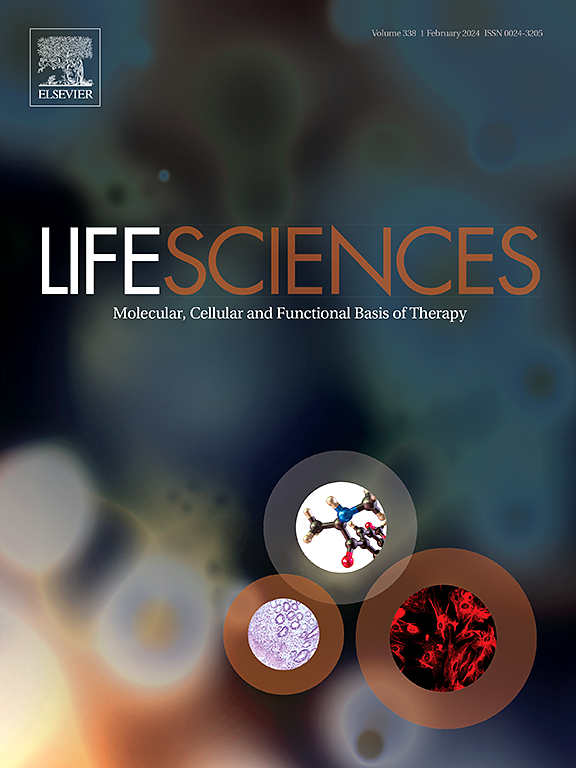骨骼肌源性外泌体通过促进骨生成预防骨质疏松症
IF 5.2
2区 医学
Q1 MEDICINE, RESEARCH & EXPERIMENTAL
引用次数: 0
摘要
骨骼肌和骨骼是身体活动的主要器官,在人的一生中,肌肉质量和骨密度之间存在着平行关系。骨质疏松症是一种全身性骨代谢疾病,由骨形成减少和骨吸收增加引起。基于骨骼肌与骨骼之间的代谢共生关系,我们假设骨骼肌分泌因子可能在骨质疏松症中发挥建设性作用。外泌体已被证实能在细胞间传递生物活性因子。然而,骨骼肌外泌体(SM-Exos)在骨质疏松症中的作用仍不清楚。在这项研究中,我们对去神经支配的骨骼肌进行了神经肌肉电刺激(NMES)干预,随后从骨骼肌中提取了外泌体(DN + ES-Exo),然后通过尾静脉将这些DN + ES-Exo注射到肉瘤骨质疏松症大鼠体内。在体外研究中,我们将不同状态的SM-Exos与分化的MC3T3-E1成骨细胞进行了共培养。简而言之,我们的研究结果表明,SM-Exos 在体内和体外都能部分促进成骨。此外,我们的研究结果表明,NMES诱导的骨骼肌收缩可在一定程度上逆转肉芽肿性骨质疏松症的发病率,而DN + ES-Exo可通过促进成骨细胞分化来改善骨质疏松症。此外,我们还发现NMES可调控骨骼肌中的多种miRNA,被SM-Exos包裹的miRNA可能以网络方式参与成骨分化。总之,本研究证实了NMES对肉芽肿性骨质疏松症的作用,并探讨了SM-Exos在改善骨质疏松症中的作用,为临床肉芽肿性骨质疏松症的物理治疗提供了有效的理论支持。本文章由计算机程序翻译,如有差异,请以英文原文为准。
Skeletal muscle-derived exosomes prevent osteoporosis by promoting osteogenesis
Skeletal muscle and bone are the major organs for physical activity, in which there is a parallel correlation between muscle mass and bone density throughout a lifetime. Osteoporosis is a systemic bone metabolic disorder caused by reduced bone formation and increased bone resorption. Based on the metabolic symbiosis relationship between skeletal muscle and bone, we hypothesis that skeletal muscle secretory factors could play constructive roles in osteoporosis. Exosomes have been verified to transfer bioactive factors among cells. However, the role of skeletal muscle derived-exosomes (SM-Exos) in osteoporosis is still unclear. In this study, we performed neuromuscular electrical stimulation (NMES) intervention on denervated skeletal muscles and subsequently extracted exosomes (DN + ES-Exo) from the skeletal muscles, and then injected these DN + ES-Exo into sarco-osteoporotic rats through tail vein. In vitro studies, we cocultured SM-Exos from different states with differentiated MC3T3-E1 osteoblasts. In brief, our research findings demonstrate that SM-Exos could partially promote osteogenesis both in vivo and in vitro. Further, our findings indicate that skeletal muscle contraction induced by NMES can reverse the incidence of sarco-osteoporosis to a certain degree, and DN + ES-Exo contributes to the improvement in osteoporosis by facilitating osteoblast differentiation. Then, we revealed that NMES might regulate several miRNAs in skeletal muscle, the miRNAs that are encapsulated by SM-Exos might be involved in osteogenic differentiation in a network manner. All in all, this study confirmed the effect of NMES on sarco-osteoporosis and explored the role of SM-Exos in the improvement of osteoporosis, which provide an effective theoretical support for the physical therapy of clinical sarco-osteoporosis.
求助全文
通过发布文献求助,成功后即可免费获取论文全文。
去求助
来源期刊

Life sciences
医学-药学
CiteScore
12.20
自引率
1.60%
发文量
841
审稿时长
6 months
期刊介绍:
Life Sciences is an international journal publishing articles that emphasize the molecular, cellular, and functional basis of therapy. The journal emphasizes the understanding of mechanism that is relevant to all aspects of human disease and translation to patients. All articles are rigorously reviewed.
The Journal favors publication of full-length papers where modern scientific technologies are used to explain molecular, cellular and physiological mechanisms. Articles that merely report observations are rarely accepted. Recommendations from the Declaration of Helsinki or NIH guidelines for care and use of laboratory animals must be adhered to. Articles should be written at a level accessible to readers who are non-specialists in the topic of the article themselves, but who are interested in the research. The Journal welcomes reviews on topics of wide interest to investigators in the life sciences. We particularly encourage submission of brief, focused reviews containing high-quality artwork and require the use of mechanistic summary diagrams.
 求助内容:
求助内容: 应助结果提醒方式:
应助结果提醒方式:


